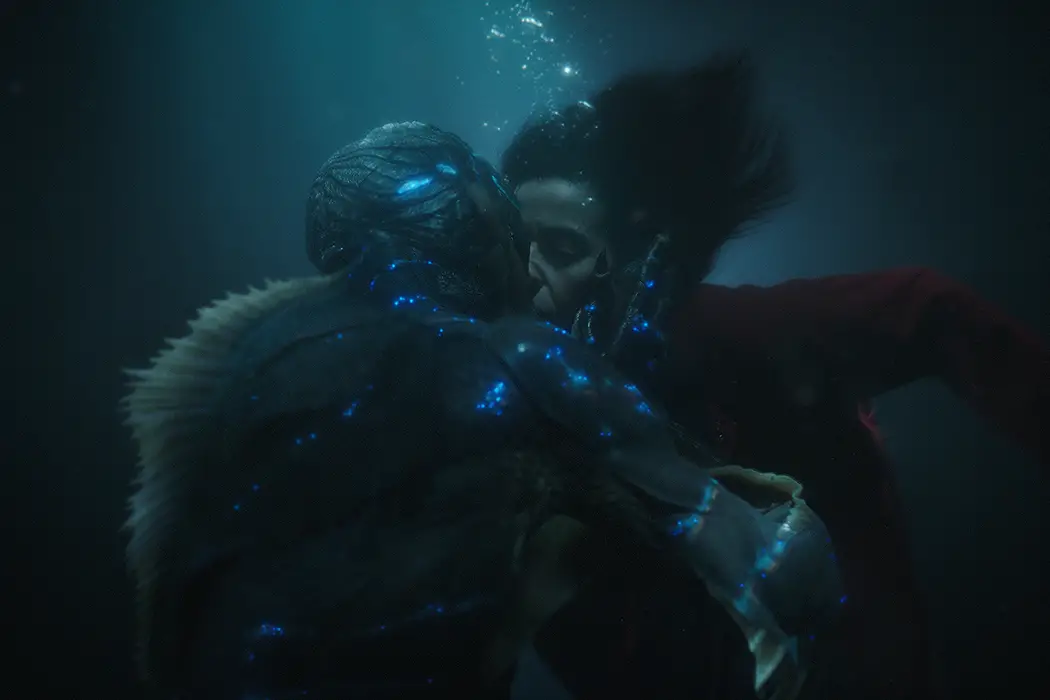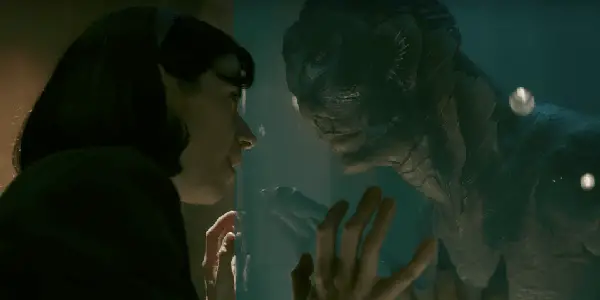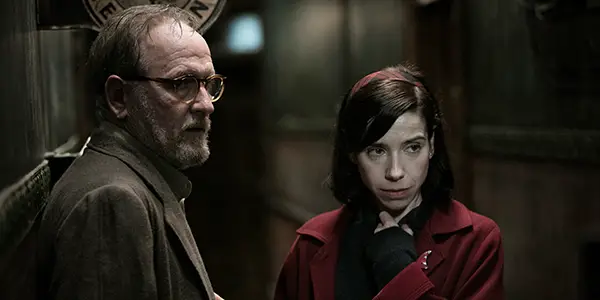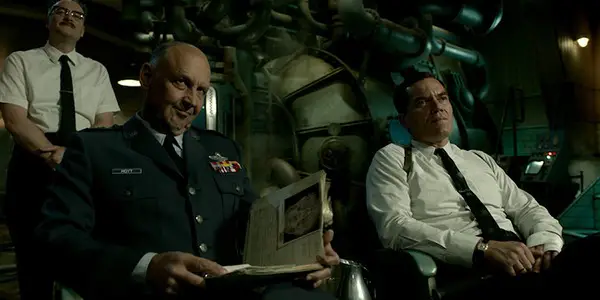THE SHAPE OF WATER: Del Toro’s Wondrous Fantasy Romance Falls Short Of Greatness

David is a film aficionado from Colchester, Connecticut. He enjoys…
When I first saw Guillermo del Toro‘s The Shape of Water, I wasn’t quite sure how I felt. It’s a film clearly made by a proficient and passionately-driven filmmaker (del Toro has even said that it’s his most personal work), and it’s also one that attempts to tackle many different subjects, both politically and socially. In addition, there is a lot to individually praise about it – from its otherworldly soundtrack, to its beautiful minimally-lit cinematography, to an all-around praiseworthy cast – yet the overall result is less than the sum of its parts.
The film is the equivalent work of an artist, who, though beginning with a solid, well-rounded image and clearly possessing the tools to finish the job, along the way just didn’t allow it to find the proper balance. In the end, perhaps The Shape of Water’s ambition just exceeded its grasp.
Fantasy-Infused Historical Fiction
The film takes place during the early 1960s in Baltimore, Maryland, at the height of the Cold War. Eliza Esposito (Sally Hawkins) is a timid yet bright woman, who was stricken mute as a young girl, and currently works as a night janitor for the Occam Aerospace Research Center. Though her days are monotonous, they are not entirely dissatisfying, often brightened up by her chatty coworker Zelda Fuller (Octavia Spencer) or her strong friendship with next door neighbor Giles (Richard Jenkins).
One day, while cleaning a high security room, an “Asset” is brought in; a giant, amphibian-like creature that is being held captive at the facility for the purposes of experimentation. Instantly curious, Eliza soon gets to know the creature in secret, bringing eggs to it, playing music, and attempting to communicate with it through sign language. She grows smitten, and, after hearing Colonel Richard Strickland (Michael Shannon) discussing his plans to execute the creature, prepares to set him free.

The initial sequences of The Shape of Water, from the calming monotony of Eliza’s daily routine to her conversations with both Zelda and Giles, set a pleasant tone right from the offset. And when the creature first emerges, it doesn’t detract from this but instead adds a lure of mystery, in a way that only a master like Guillermo del Toro could properly manage.
The creature, played by frequent collaborator Doug Jones, is brought to life through mostly practical effects, and its eventual result is amongst his more extraordinary creations. A clear inspiration is Creature from the Black Lagoon, with its tall stature and amphibious appearance, yet Del Toro also softens his facial features, making the creature more sympathetic and lovable from the get-go, which is also helped along by Jones‘ sensitive performance.
Visually, and in individual sequences, the film is a treat, bathed in a blue and green color palette, with beams of glowing light often outlining characters’ faces. There are also, not unexpectedly, frequent motifs of flowing water, which sometimes even transpose a shot from one scene to the next.
Finally, one would be remiss not to mention Alexandre Desplat‘s marvelous score, with music ranging from soothing French-inspired lullabies blended with ethereal sound effects, to delightful variations on classics, such as the 1940s hit “You’ll Never Know,” sung here by Reneé Fleming. Listening to the score afterwards, as with most great movie soundtracks, you’re instantly transported back into Del Toro‘s vibrantly-tinted world.
A Whirlwind of Talent
The Shape of Water also contains one of the finer casts of the year. Front and center is the spellbinding Sally Hawkins as Eliza. As the film itself is at least somewhat inspired by classic movies, Hawkins’ Eliza is a character seemingly pulled straight out of a silent movie. Wordless for much of the film, she somehow manages a dynamic range of emotion using simply facial tics and wide-eyed expressions – it’s remarkable when thinking back to it, as you almost remember her having engaged in conversations despite her (almost) complete lack of dialogue. The film also utilizes classic musicals as a way to show Eliza’s buoyant nature, having her dance through the halls or even engage in spontaneous dance reenactments (including one recreation of a classic black-and-white musical that is unfortunately just a tad too short).
Eliza’s actual relationship with the Asset might at first be an awkward one; after all, how does a human female and an amphibious creature fall in love in the first place (emotionally, or even harder to answer, physically?) Really, though, the film is basically Beauty and the Beast meets Jean-Pierre Jeuenet‘s Amélie. Through Hawkins’ and Jones’ commitment, and Del Toro‘s direction, the romance is about as believable as any compelling romantic drama.

Alongside Hawkins, the scene-stealer here is the wonderful Richard Jenkins, who brings a warmhearted sensitivity to the middle-aged, closeted, starving-artist Giles, a man who claims that he “isn’t good at this” when helping Eliza free the creature from the facility, yet soon proves that he is that and much more. Spencer‘s talkative Zelda provides a comical contrast to the quiet Eliza, while Dr. Robert Hofstetler (the always delightful to see Michael Stuhlbarg), a doctor studying the creature, holds a much more important role to the film than one would initially suspect.
Yet inconsequential as a whole
The Shape of Water shoots for the stars, and it sometimes almost achieves its lofty reach, yet the eventual result falls short. The best example of this would be in the scenes immediately following the exchanges between Eliza and the creature. After but a few moments granted for the two to bond, an already curious choice since the romance is meant to be the centerfold of the film, Del Toro then takes us off on several distinct side stories, including Giles’ attempts to make it as an artist, Dr. Hofstetler’s mysterious second life, Colonel Strickland’s bizarre interactions with his family, and more. It’s just a tad too much, with each story not being allowed to breathe or develop on its own. As a result, they unfortunately distract from the conflict and romance that should instead be front and center.

In addition, the film attempts too much politically. As it takes place during the 1960s, when US/Soviet tensions were at an all-time high, this is brought into the story’s events. Yet, by the conclusion, the conflict here feels superfluous as a whole, and doesn’t organically weave into the central story. What Del Toro does at least valiantly attempt is to humanize the Soviet spy that is focused on in the film, showing how people, though within certain demographics, might not actually be bad at heart. Meanwhile, the celebrated American Colonel Strickland, who Shannon plays with a mixture of menace and deadpan humor, is about as evil as they come.
The Shape of Water also makes feeble attempts at social commentary, including focuses on race and homosexuality, yet also not in any profoundly effective way. The vague outline for sociopolitical commentary as a whole is here, and in a way that should be praised (especially given the status of our current world), yet it never felt as fleshed-out as it has in past Del Toro films. Pan’s Labyrinth, for example, weaves together the brutality of post-Civil War Spain with the dark imagination of a young girl attempting to make sense of her war-torn world. In The Shape of Water, the fantasy and sociopolitical sides never come together in the same seemingly effortless way.
Verdict: The Shape of Water
To conclude, The Shape of Water is a conflicting film. It, at times, had me beaming with ecstatic joy, admiring Guillermo del Toro‘s immaculate talent for visually adept art. Yet, at other points, and as a whole, it just feels so unfortunately slight. For a master at the peak of his craft, there’s a lot to praise, but for an avid watcher of his films expecting yet another masterwork, The Shape of Water is just too shallow to completely commend.
What are your thoughts? Does The Shape of Water work as a dark fairy tale, or does it fall short?
The Shape of Water got a limited release in the US on December 8th, and gets a wide release on December 22nd. It will see release in the UK on February 14th. For international release dates, click here.
Does content like this matter to you?
Become a Member and support film journalism. Unlock access to all of Film Inquiry`s great articles. Join a community of like-minded readers who are passionate about cinema - get access to our private members Network, give back to independent filmmakers, and more.
David is a film aficionado from Colchester, Connecticut. He enjoys writing, reading, analyzing, and of course, watching movies. His favorite genres are westerns, crime dramas, horror, and sci-fis. He also enjoys binge-watching TV shows on Netflix.













